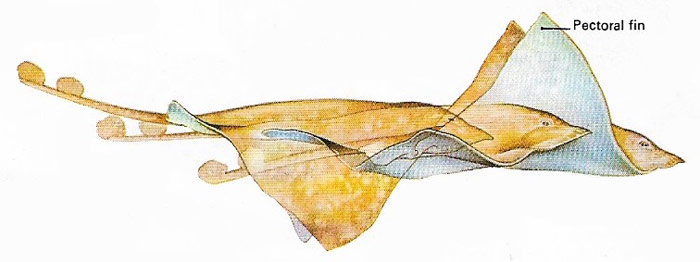Chondrichthyes

The blue shark has the typical heterocercal tail, pointed dorsal and horizontally held pectoral fins. This shark has five gill slits in each side of the body. Many sharks have a spiracle behind each eye, through which water flows to the gills. Like most other fish the shark also uses its mouth to take in water. The blue shark is among the most voracious of all predatory fish.

Most rays are primarily bottom-feeders relying on camouflage for protection. If threatened, a ray swims by flapping its pectoral fins.
Chondrichthyes, the cartilaginous fish, is a class of the phylum Chordata (see chordate) that includes the sharks, skates, rays, and the extinct bradyodonts. They are characterized by skeletons made of cartilage and scales that are tooth-like.
On the evolutionary scale Chondrichthyes are more primitive than Osteichthyes (bony fish). About 620 extant species are known, divided zoologically into three groups: the typical sharks (Elasmobranchii), the skates and rays (Batoidea), and an odd-looking group of uncertain ancestry, the chimeras (Holocephali). A characteristic of most cartilaginous fish is the heterocercal tail whose top half is longer than the bottom. To balance the effect of this on swimming ability the shark has fixed pectoral fins and a flattened head.
Most sharks are fast-moving hunters and are by nature fish-eaters, but they will, in exceptional circumstances such as severe hunger, attack and savage mammals, including humans. Skates and rays are found patrolling the ocean floor feeding on sedentary shellfish.
The largest of the cartilaginous fish are ironically the least ferocious and represent no threat to most of their undersea neighbors. The whale shark, which reaches a length of 18 meters (60 feet), the basking shark 14 meters (46 feet), and the manta ray, which has a "wing span" of 6 meters (20 feet), feed only on plankton and other minute marine animals. For all their immense size the whale and basking sharks feed on small creatures and have comb-like structures on their gills through which they strain their food.
Most cartilaginous fish, such as the blue shark and smooth dogfish, give birth to live young, but some lay large, yolky eggs which, before being laid, are individually encased in a tough, leathery cover. After the eggs have hatched, the empty cases can often be found on the sea-shore and are popularly known as "mermaids purses." Fertilization is internal and the male has modified pelvic fins, the claspers, with which he holds on to the female during mating.
All cartilaginous fish, with the exception of sawfish and some species of ray, are marine. By contrast the 20,000 or so species of bony fish are found in both sea and fresh water throughout the world.


